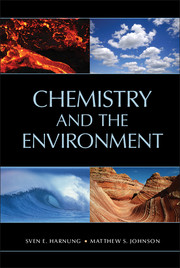Book contents
- Frontmatter
- Contents
- Preface
- Acknowledgments
- Chemistry and the Environment
- Introduction
- 1 The Earth
- 2 Environmental dynamics
- 3 The Spheres
- 4 Chemistry of the atmosphere
- 5 Chemistry of the hydrosphere
- 6 Chemistry of the pedosphere
- 7 Global cycles of the elements
- 8 The chemicals industry
- 9 Environmental impact of selected chemicals
- 10 The chemistry of climate change
- Appendix 1
- Appendix 2
- Appendix 3
- Appendix 4
- Appendix 5
- References
- Name index
- Subject index
- Miscellaneous Endmatter
2 - Environmental dynamics
Published online by Cambridge University Press: 05 November 2012
- Frontmatter
- Contents
- Preface
- Acknowledgments
- Chemistry and the Environment
- Introduction
- 1 The Earth
- 2 Environmental dynamics
- 3 The Spheres
- 4 Chemistry of the atmosphere
- 5 Chemistry of the hydrosphere
- 6 Chemistry of the pedosphere
- 7 Global cycles of the elements
- 8 The chemicals industry
- 9 Environmental impact of selected chemicals
- 10 The chemistry of climate change
- Appendix 1
- Appendix 2
- Appendix 3
- Appendix 4
- Appendix 5
- References
- Name index
- Subject index
- Miscellaneous Endmatter
Summary
Introduction
The environment is in a constant state of change. In order to describe this adequately, this chapter reviews environmental dynamics, the unification of fluid dynamics, chemical thermodynamics, and chemical kinetics.
An important goal of environmental chemistry is to model Nature, including predicting the fate of a given chemical species, whether of natural or anthropogenic origin. The purpose of this chapter is to establish the nomenclature used in the book and to present fundamental concepts and expressions. It is particularly important to derive the explicit time dependence of the relevant physical quantities. In separate sections of this introduction, we first describe and define a few basic concepts, and then introduce important concepts for the time dependence of concentration, field, and transport.
Basic concepts
System and phase
The concepts of system, surroundings, and phase used in thermodynamics are the cornerstones of any environmental investigation. A system is the part of the world that has been chosen as the subject of study; it may contain matter, in which case it also contains energy. Everything else is said to belong to the surroundings. The separating boundary may be real or imaginary, but must be defined before the study begins. Depending on the properties of the boundary, one can define three types of system. An open system is one that can exchange substance and energy (work, heat, radiation) with the surroundings. A closed system cannot exchange substance with the surroundings, and an isolated system can exchange neither substance nor energy with the surroundings. Except in the last case, the surroundings enter the physical description, because they must have certain properties as sources or sinks for the exchanged physical quantities.
- Type
- Chapter
- Information
- Chemistry and the Environment , pp. 37 - 97Publisher: Cambridge University PressPrint publication year: 2012



